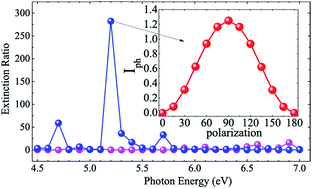Highly polarization-sensitive, visible-blind and self-powered ultraviolet photodetection based on two-dimensional wide bandgap semiconductors: a theoretical prediction†
Abstract
Two-dimensional wide bandgap (2D-WBG) semiconductors have attracted extensive research interest in ultraviolet (UV) photodetection because of their excellent performances including ultrafast response, high responsivity and low dark current. Using quantum transport simulations, we proposed here a kind of self-powered, visible-blind and UV-polarized photodetector driven by the photogalvanic effect (PGE) based on several 2D-WBG (3.0–7.41 eV) semiconductors and their heterostructures. Such 2D-WBG semiconductors show sharp optical absorption peaks ranging from 4 eV to 8 eV, which is suitable for a variety of application fields in UV photodetection. We also designed a vertical van der Waals heterostructure (vdWh) with a type-II energy band alignment composed of 2D monolayer MgBr2 and CdCl2. Robust PGEs can be induced in the photodetectors based on this vdWh and also on monolayer ZrNY (Y = Cl and Br) due to the C3v symmetry under the illumination of both linearly and elliptically polarized light. The broadband and highly polarization-sensitive photocurrent is therefore generated at zero bias voltage, which exhibits a remarkably high extinction ratio of up to 280. These results suggest a promising mechanism for polarization-sensitive and visible-blind UV photodetection with low power consumption.



 Please wait while we load your content...
Please wait while we load your content...